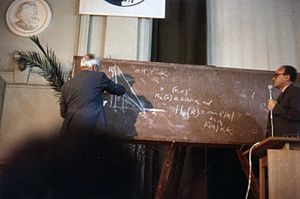Andrei Kolmogorov
Andrei Nikolayevich Kolmogorov (Russian: Андре́й Никола́евич Колмого́ров; Tambov, April 25, 1903-Moscow, October 20, 1987) was a Russian mathematician who made first-line contributions to the contents theory of probability and topology. He structured the axiomatic system of probability theory, using the language of set theory, where the elements are events. He worked on constructivist logic; in the Fourier series; in turbulence and classical mechanics. He founded the theory of algorithmic complexity. In 1929, under the supervision of the mathematician Nikolai Luzin, he received his doctorate at Moscow State University.
Biography
Early Years
His mother, Maria Yákovlevna Kolmogórova, died in childbirth and his father, the agronomist Nikolai Matvéyevich Katáyev, abandoned him first and then perished in 1919, in the middle of the Russian civil war, during the offensive of the white general Anton Denikin. He was adopted by Vera Yakovlevna Kolmogorov, his mother's sister, at the estate of his grandfather Yakov Stepanovich Kolmogorov, a wealthy nobleman, in Tunoshna, near Yaroslavl.
At the school in that town, his first literary efforts and mathematical papers were printed in the school newspaper. In his teens, while designing perpetual motion machines, he hid his (necessary) flaws so cleverly that his high school teachers couldn't discover them.[citation needed]
In 1920, he began studying at Moscow State University and the Technological Institute of Chemistry. There he earned a great reputation for his learning. He participated in the seminars of the historian Sergei Bajrushin and wrote his first research paper on land tenure practices in the Novgorod Republic in the 15th and 16th centuries. At the same time (1921-1922), he obtained his first results in the theory of sets and in the theory of Fourier series (trigonometric series).
Maturity
In 1922, he published his first results in set theory and a year later, he constructed a Fourier series that diverges almost everywhere, earning notable international recognition. In that time, he decided to dedicate his life to mathematics and published eight papers on integration theory, Fourier analysis, and probability theory.
In 1929 he obtained his Doctor of Physics and Mathematics, Ph.D., from Moscow State University. From that year, and until the death of the mathematician Pavel Aleksandrov, he was his partner. Together they participated in the political persecution of their teacher in 1936, in the so-called Luzin case, together with Aleksandr Jinchin and Sergei Sobolev.
In 1930, Kolmogorov made his first long trip abroad, to Göttingen and Munich, and then to Paris. His pioneering work on the methods of analysis of Probability Theory was published in German in 1931, the year he became a professor at Moscow State University.
In 1933, Kolmogorov published the book The Fundamentals of Probability Theory, in which he laid down the modern foundations of the axiomatic theory of probability and thanks to which he gained a reputation as one of the greatest experts in the world.
In 1939, he was elected a Full Member of the Russian Academy of Sciences. In a 1938 paper, he published "established the basic theorems of smoothing and prediction of stationary stochastic processes"; — a document that would have important military applications during the Cold War to come.
In their study of stochastic processes (random processes), especially Markov processes, Kolmogorov and British mathematician Sydney Chapman independently developed the set of fundamental equations in the field, the Chapman-Kolmogorov equations.
Later, he switched research interests to the zone of turmoil, where his publications beginning in 1941 had a significant influence on the field. In classical mechanics, he is best known for the Kolmogorov-Arnold-Moser Theorem (first presented in 1954 at the International Congress of Mathematicians). In 1957 he solved Hilbert's thirteenth problem (a joint work with his student Vladimir Arnold). He was a founder of algorithmic complexity theory, often called Kolmogorov complexity theory, which he began to develop around this time.
He married childhood friend Anna Dmitrievna Yegorova in 1942. A strong teaching routine was applied throughout his life, not only at the university level, but also with younger children, as he was heavily involved in the development of a pedagogy for gifted children, in literature and music, as well as in mathematics. At Moscow State University, he held different positions, including heading various departments: probability, statistics, and chance processes, mathematical logic, and served as dean of the Moscow Faculty of Mechanics and Mathematics.
In 1971, he joined an oceanographic expedition aboard the research vessel Dmitri Mendeleev. He wrote articles for the Great Soviet Encyclopedia. In his later years he devoted much of his effort to the mathematical and philosophical relationship between probability theory in the abstract and applied areas.
Honors
Received many honors from many countries:
- In 1939 he was elected a member of the Russian Academy of Sciences.
- He received one of the first prizes of the State in 1941.
- Lenin Prize in 1965.
- Lenin's order on six occasions.
- Lobachevsky Medal in 1987.
He was recognized by other academies and societies, such as:
- Romanian Academy of Sciences (1965),
- Royal Statistical Society of London (1956),
- German Academy of Natural Sciences Leopoldina (1959),
- American Academy of Arts and Sciences (1959),
- London Mathematical Society (1959),
- American Philosophical Society (1961),
- Indian Institute of Statistics (1962),
- Royal Academy of Arts and Sciences of the Netherlands (1963),
- Royal Society of London (1964),
- United States National Academy (1967),
- French Academy of Sciences (1968).
Quotes
He is credited with saying:[citation needed]
"Every mathematician thinks he's ahead of everyone else. The reason they don't say it in public is because they're smart people.".
Contenido relacionado
Benoit Mandelbrot
Gaspard Monge
Pafnuti Chebyshov
Mary D'Empire
Olga Ladyzhenskaya

